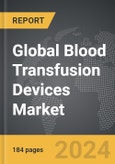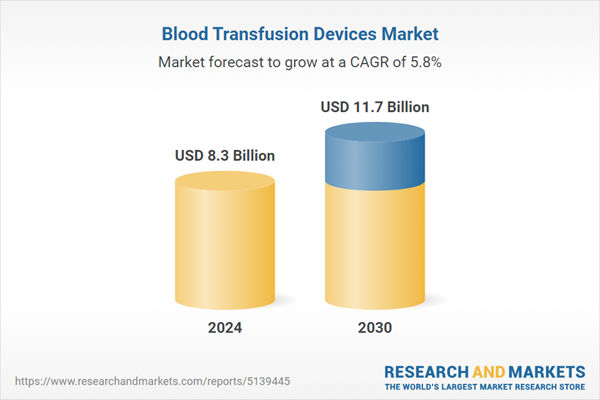Global Blood Transfusion Devices Market - Key Trends and Drivers Summarized
Why Are Blood Transfusion Devices Crucial in Modern Medical Care?
Blood transfusion devices are essential tools in healthcare, facilitating the safe and efficient transfer of blood and blood products from donors to patients in need. These devices play a critical role in a wide range of medical situations, including surgeries, trauma care, and the treatment of chronic conditions such as anemia and cancer. Blood transfusion devices ensure that the correct volume and type of blood are delivered to patients, minimizing the risk of complications such as transfusion reactions and infections. The precision and reliability of these devices are vital in maintaining the integrity of the blood supply and ensuring that patients receive the lifesaving treatment they require. As the demand for blood transfusions continues to grow globally, particularly in emergency care and surgical procedures, blood transfusion devices remain indispensable in delivering high-quality healthcare.How Has Technology Advanced the Capabilities of Blood Transfusion Devices?
The development of blood transfusion devices has been significantly enhanced by technological advancements, leading to more sophisticated, accurate, and user-friendly systems. Initially, blood transfusions were conducted using basic equipment, which often required manual operation and posed a higher risk of error. The introduction of automated transfusion devices revolutionized the process by enabling precise control over blood flow rates, reducing the likelihood of human error, and improving patient safety. Modern blood transfusion devices now incorporate advanced features such as automated volume measurement, air detection systems, and integrated warming units to ensure that blood is delivered at the optimal temperature. Additionally, advancements in portable and battery-operated transfusion devices have made it possible to administer blood in a variety of settings, including remote locations and during transport, thereby extending the reach of emergency medical care. These technological innovations have greatly improved the safety, efficiency, and accessibility of blood transfusions, making them more reliable and effective across different medical scenarios.What Are the Latest Trends and Innovations in Blood Transfusion Devices?
The field of blood transfusion devices is currently experiencing several key trends and innovations aimed at improving patient outcomes and enhancing the efficiency of transfusion procedures. One of the most significant trends is the development of smart transfusion devices that utilize digital technologies to monitor and adjust transfusion parameters in real-time. These devices can automatically detect and respond to changes in a patient's condition, ensuring that the transfusion is delivered safely and effectively. Another emerging trend is the increasing use of wireless connectivity in transfusion devices, allowing for seamless integration with hospital information systems and enabling remote monitoring by healthcare providers. Additionally, there is a growing focus on the miniaturization of transfusion devices, which has led to the creation of more compact, portable units that are ideal for use in field hospitals, ambulances, and other mobile healthcare settings. Innovations in disposable transfusion sets, designed to reduce the risk of cross-contamination and improve patient safety, are also gaining traction. These trends and innovations are transforming blood transfusion practices, making them safer, more efficient, and more adaptable to a variety of clinical environments.What's Driving the Growth in the Blood Transfusion Devices Market?
The growth in the blood transfusion devices market is driven by several key factors that reflect the evolving needs of healthcare systems worldwide. One of the primary drivers is the increasing demand for blood transfusions due to the rising prevalence of chronic diseases, aging populations, and the growing number of surgical procedures being performed globally. As healthcare systems expand and improve, particularly in emerging markets, the need for reliable and advanced transfusion devices is becoming more pronounced. Technological advancements, such as the development of smart and portable transfusion devices, are also fueling market growth by offering more efficient and flexible solutions for both hospital and emergency care settings. Furthermore, the heightened focus on patient safety and infection control, driven by stricter regulatory standards and guidelines, is pushing healthcare providers to adopt newer, more sophisticated transfusion devices. The expansion of telemedicine and remote healthcare services is further driving demand for devices that can be used in non-traditional healthcare environments. These factors, combined with continuous innovation in device technology, underscore the critical role that blood transfusion devices play in modern healthcare, ensuring that patients receive safe and effective transfusions whenever and wherever they are needed.Report Scope
The report analyzes the Blood Transfusion Devices market, presented in terms of market value (USD). The analysis covers the key segments and geographic regions outlined below.- Segments: Segment (Pathogen Reduction System, Apheresis Device, Blood Component Separator, Fridge & Freezer, Blood Bag & Accessory, Blood Mixer, Other Segments).
- Geographic Regions/Countries: World; United States; Canada; Japan; China; Europe (France; Germany; Italy; United Kingdom; Spain; Russia; and Rest of Europe); Asia-Pacific (Australia; India; South Korea; and Rest of Asia-Pacific); Latin America (Argentina; Brazil; Mexico; and Rest of Latin America); Middle East (Iran; Israel; Saudi Arabia; United Arab Emirates; and Rest of Middle East); and Africa.
Key Insights:
- Market Growth: Understand the significant growth trajectory of the Pathogen Reduction System segment, which is expected to reach US$3.7 Billion by 2030 with a CAGR of 6.3%. The Apheresis Device segment is also set to grow at 5.5% CAGR over the analysis period.
- Regional Analysis: Gain insights into the U.S. market, valued at $2.2 Billion in 2024, and China, forecasted to grow at an impressive 9% CAGR to reach $2.7 Billion by 2030. Discover growth trends in other key regions, including Japan, Canada, Germany, and the Asia-Pacific.
Why You Should Buy This Report:
- Detailed Market Analysis: Access a thorough analysis of the Global Blood Transfusion Devices Market, covering all major geographic regions and market segments.
- Competitive Insights: Get an overview of the competitive landscape, including the market presence of major players across different geographies.
- Future Trends and Drivers: Understand the key trends and drivers shaping the future of the Global Blood Transfusion Devices Market.
- Actionable Insights: Benefit from actionable insights that can help you identify new revenue opportunities and make strategic business decisions.
Key Questions Answered:
- How is the Global Blood Transfusion Devices Market expected to evolve by 2030?
- What are the main drivers and restraints affecting the market?
- Which market segments will grow the most over the forecast period?
- How will market shares for different regions and segments change by 2030?
- Who are the leading players in the market, and what are their prospects?
Report Features:
- Comprehensive Market Data: Independent analysis of annual sales and market forecasts in US$ Million from 2024 to 2030.
- In-Depth Regional Analysis: Detailed insights into key markets, including the U.S., China, Japan, Canada, Europe, Asia-Pacific, Latin America, Middle East, and Africa.
- Company Profiles: Coverage of players such as 3M Company, Abbott Laboratories, B. Braun Melsungen AG, Becton Dickinson and Company, Baxter International Inc. and more.
- Complimentary Updates: Receive free report updates for one year to keep you informed of the latest market developments.
Some of the 22 companies featured in this Blood Transfusion Devices market report include:
- 3M Company
- Abbott Laboratories
- B. Braun Melsungen AG
- Becton Dickinson and Company
- Baxter International Inc.
- Terumo Corporation
- Fresenius Kabi AG
- Grifols SA
- Immucor, Inc.
- Kawasumi Laboratories, Inc.,
- Fenwal
- Haemonetics Corporation
- Macopharma SA
- Neomedic Limited
- RAYS S.P.A
This edition integrates the latest global trade and economic shifts into comprehensive market analysis. Key updates include:
- Tariff and Trade Impact: Insights into global tariff negotiations across 180+ countries, with analysis of supply chain turbulence, sourcing disruptions, and geographic realignment. Special focus on 2025 as a pivotal year for trade tensions, including updated perspectives on the Trump-era tariffs.
- Adjusted Forecasts and Analytics: Revised global and regional market forecasts through 2030, incorporating tariff effects, economic uncertainty, and structural changes in globalization. Includes historical analysis from 2015 to 2023.
- Strategic Market Dynamics: Evaluation of revised market prospects, regional outlooks, and key economic indicators such as population and urbanization trends.
- Innovation & Technology Trends: Latest developments in product and process innovation, emerging technologies, and key industry drivers shaping the competitive landscape.
- Competitive Intelligence: Updated global market share estimates for 2025, competitive positioning of major players (Strong/Active/Niche/Trivial), and refined focus on leading global brands and core players.
- Expert Insight & Commentary: Strategic analysis from economists, trade experts, and domain specialists to contextualize market shifts and identify emerging opportunities.
Table of Contents
Companies Mentioned (Partial List)
A selection of companies mentioned in this report includes, but is not limited to:
- 3M Company
- Abbott Laboratories
- B. Braun Melsungen AG
- Becton Dickinson and Company
- Baxter International Inc.
- Terumo Corporation
- Fresenius Kabi AG
- Grifols SA
- Immucor, Inc.
- Kawasumi Laboratories, Inc.,
- Fenwal
- Haemonetics Corporation
- Macopharma SA
- Neomedic Limited
- RAYS S.P.A
Table Information
| Report Attribute | Details |
|---|---|
| No. of Pages | 184 |
| Published | November 2025 |
| Forecast Period | 2024 - 2030 |
| Estimated Market Value ( USD | $ 8.3 Billion |
| Forecasted Market Value ( USD | $ 11.7 Billion |
| Compound Annual Growth Rate | 5.8% |
| Regions Covered | Global |









